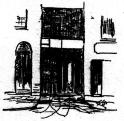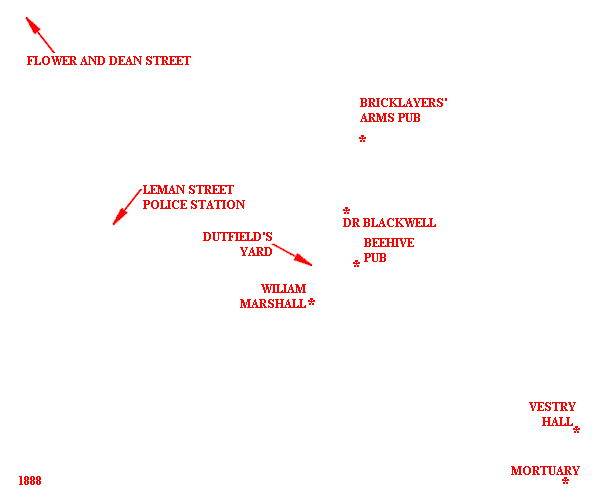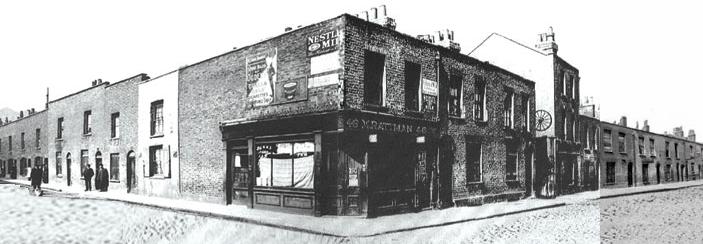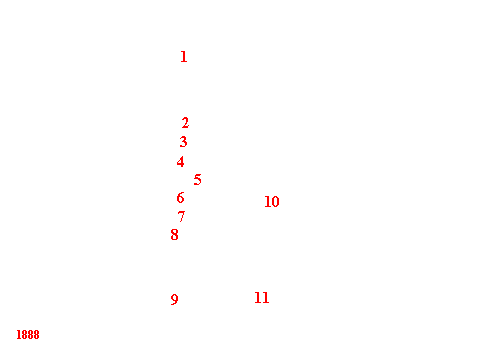|
Explore JTR
- Maps
|

|
|
Explore JTR
- Maps
|

|
|
[Area Map]
[Description]
[Detail Map]
|

|
[Click Here for the Historical Development of Berner Street]

[Click Here for a Descriptive Tour]
Berner Street is a residential street located in the Northern area of
St. George's-in-the-East parish, near Whitechapel. It ran North-South
from Commercial Road to Ellen Street, (two blocks south of Boyd Street).
Berner Street ended at the London, Tilbury and Southern railway. It is
crossed by Fairclough Street at its midpoint. Beyond Ellen Street lay
the Swedish Church.
On Berner Street's Western-side, heading North of Fairclough Street, lay
a public house, The Nelson, (#46, North-West corner of Fairclough & Berner
Streets); Matthew Packer's greengrocer's shop (#44); a cottage (#42); a
double-gated entry, leading to Dutfield's Yard; The International
Workingmen's Educational Club (#40); residence of Barnett Kentorrich (#38),
residence of Mrs Fanny Mortimer (#36)and more cottages, including Charles
Letchford's residence (#30) and Edwin Sumner's greengrocer shop (#2).
On Berner Street's Eastern-side (North of Fairclough), stood several
houses with a board school (#25-41) at the North-East corner of Fairclough
& Berner Streets. on the South-East corner of the junction was a dwelling
house (#43).
On the South-West Corner of this junction was Henry Norris's chandler
shop (#48, opposite The Nelson). On the Western-side of Berner Street
heading South from Fairclough Street was William Marshall's residence
(#64). On the Northern corner of Boyd & Berner Streets was the George
IV public house (#68, owned by Edmund Farrow). Continuing South on the
Western-side there was Louis Friedman's baker shop (#70), Jacob Lubin's
greengrocer shop (#74), and a chemist, John Simkin (#82).
There were 82 "numbers" listed on Berner Street at the time.
The International Workingmen's Educational Club (IWEC or the club) sat
north of and adjacent to Dutfield's Yard. It was an old wooden house
converted for use as a social club capable of holding over two hundred
people. A stone office, consisting of two rooms, was added onto the rear
of the club. One of those rooms was used by the editor of Der Arberter
Fraint, and the other was used as a composing room. The front of the
ground floor sported one window and door. The street entrance opened to
a hallway which ran the length of the house. One door in the hallway led
to the front room, used as dining room. A staircase leading to the first
floor was in the middle of the hallway. Past the stairs, a door lead to
the kitchen, (a rear ground floor room). Beyond that door, another door
lead to a passage which ran along side the house. The first floor contained
a room used for entertainment. The front of the room held a small stage.
The only windows, three, looked out at the rear of the house. The room
was decorated with plain benches, and several portraits hung on the walls.
To the left of the IWEC's front entrance was Dutfield's Yard.
The yard was named after Arthur Dutfield, a manufacturer of vans and carts
whose business lay to the west of the yard. Entrance into the yard from
Berner Street was gained via a 9'-2" wide gateway, supporting two wooden
gates which swung into the yard. A small man-door was set within one of
the gates. Inside the gateway, a passage ran along the IWEC, leading to
its rear entrance. Opposite of which were two lavatories. To the south of
the yard was a house occupied by several tenants. Opposite the gateway was
Walter Hindley's workshop for manufacturing sacks. Next to the workshop was
an unused stable, which was next to the rear of the club. The yard had no
light of its own. The light which emanated from the club's first floor fell
more on the opposite cottages than into the yard. Light from the club's
open kitchen door and from Der Arberter Fraint's offices fell further up
the yard. For about eighteen feet inside the gateway, there was typically
no light after sunset; yet, this area was not unfrequented.

|
1. Charles Letchford (30 Berner St) 2. Fanny Mortimer (36 Berner St) 3. Barnett Kentorich (38 Berner St) 4. IWEC (40 Berner St) 5. Dutfield's Yard (murder scene) 6. Cottage (42 Berner St) 7. Matthew Packer (44 Berner St) 8. The Nelson pub (46 Berner St) 9. Henry Norris' Chandler Shop (48 Berner St) 10. Board School (25-41 Berner St) 11. House (43 Berner St) |
For sources used, refer to the Time Line of the specific victim.
Many THANKS to the people who have contributed to this page:
Geographical assistance - Courtesy of The Viper.
Dutfield's Yard image - Courtesy of New York Herald.
Pub addresses - Courtesy of Ripperologist, issues #22 and #23.
88 detail map extract - Courtesy of Goad's Fire Plan via The Viper.
88 area map extract - Courtesy of G. Bacon's New Large-Scale Ordnance
Atlas.
Re-touched composite photo of Berner Street - originals Courtesy of Stephen Thomas via Casebook.